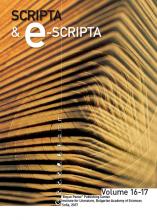Sebastian Kempgen
Sv. Kliment Ohridski: His Tombstone and its Inscription
-
Summary/Abstract
In the Presveta Bogoroditsa Perivlepta church in Ohrid the tombstone of St Kliment Ohridski is preserved. This large stone slab, with several inscriptions from the thirteenth and sixteenth centuries, remained there, while the holy relics of St Kliment have been transferred back to its original place – the church, built by the saint himself (completely rebuilt in 2001–2002). Until recently not much attention has been given to the tombstone. The paper offers a new reading of the main inscription, illustrated by the first contemporary picture and a new drawing made out of it, thus correcting many mistakes in the earlier publications.
